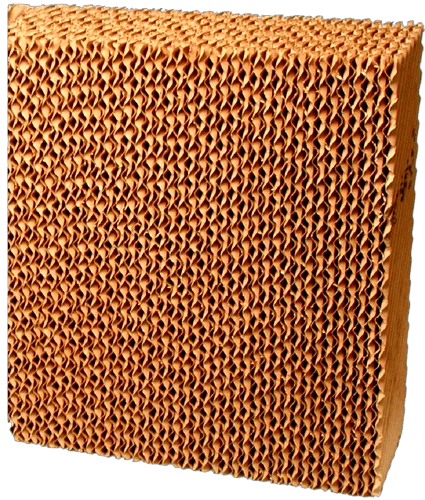By Adven Simarmata. Last updated on October 28th, 2023.

Evaporative air coolers are cooling systems that use the natural evaporation of water to cool indoor or outdoor spaces. They come in various sizes and capacities. Some models can only cool a small area, while others can cool a large area. Some models are portable, and others are fixed on the roof, wall, or floor. For simplicity, this article will be focused on discussing the portable evaporative air cooler used to cool a small indoor room, such as a bedroom or a living room. Figure 1 shows the sample of this specific model.
Evaporative air coolers offer several advantages over refrigerated air-conditioning systems, such as lower power consumption and less environmental impact. Before discussing how they have these advantages, let’s look at the steps on how the evaporative air cooler cools the indoor area. Figure 2 illustrates the components of a portable evaporative air cooler.
The Steps an Evaporative Air Cooler Cooling the Indoor Area
These are the steps the evaporative air cooler cooling the indoor area:

- The pump draws water from the water tank to wet the cooling pad.
- Warm air, which usually comes from outside of the room through the window or door, passes through the wet cooling pad. The moisture in the cooling pad absorbs the heat from the incoming air, reducing the temperature of the air. Giving heat to the moisture makes some of the moisture evaporate.
- A fan blows the cooled air along with the evaporated water, cooling and humidifying the indoor room. This cycle is continuously repeated.
The evaporative air coolers cool the outdoor area in the same way as the models that are designed to cool the indoor area. It just needs to be highlighted in Step 2 that indoor evaporative air coolers work best if the window or door is opened, unlike refrigerated air conditioners. Continuously circulating fresh air into the room prevents the room from getting too humid since the evaporation of water continuously adds humidity to the room.
Cooling Pad

The cooling pad largely determines the cooling efficiency of the evaporative air cooler. The cooling pad is designed to be able to absorb water and retain the water for a long time. When the pump draws the water to the cooling pad, the water is distributed well across all surface areas of the cooling pad, and this distributed water is called moisture. The larger the surface area of the cooling pad, the larger the contact area between the incoming warm air and the moisture, and hence the bigger the cooling effect will be.
There are various types of cooling pads, such as wood wool cooling pads and honeycomb cooling pads; each type has advantages and disadvantages. The most efficient cooling pad in the market, also the most used in modern evaporative air coolers, is the honeycomb cooling pad, shown in Figure 3. Other than being more efficient, honeycomb cooling pads also need less maintenance or cleaning. They are also more durable than most of the other types of cooling pads; they can last for 2-5 years after the first usage.
The shape of the honeycomb cooling pad resembles a honeycomb. It has a lot of holes, so there are hardly any restrictions for air to pass through, making it more energy efficient. It is made of cellulose materials that are capable of absorbing and retaining water to provide maximum cooling efficiency.[1]
One of the drawbacks of honeycomb cooling pads is they are more expensive than the other types. However, since it is more durable, they are cost-effective. Another disadvantage of honeycomb cooling pads is they release a bad odor when they are still new because many manufacturers use formaldehyde as an anti-rot chemical. Fortunately, this odor will diminish after a few days of usage.
Additional Components
The functions of the main components, i.e. the cooling pad, fan, pump, and water tank, have been clearly stated in the Steps section. Now, let’s look at the functions of the additional components:
1. Dust Filter
The function of the dust filter is to trap dust from the incoming air. This is to reduce the chance of the dust going directly to the cooling pad since dust accumulation in the cooling pad can reduce the cooling efficiency of the evaporative air cooler.
2. Adjustable Louvers
The evaporative air coolers usually come with adjustable louvers to direct the flow of the air horizontally or vertically, depending on the model.
3. Caster Wheels
The portable units usually come with caster wheels so that the units can be easily moved.
Applications
Evaporative air coolers are available in various specifications to adjust to different applications, such as residential, commercial, and industrial applications. Some are designed to cool small rooms in the house. Some are designed to cool commercial areas, such as outdoor training facilities, sports fields, and large garages. And some others are designed to cool industrial areas, such as warehouses, factories, and poultry farms.
Effective Use and Maintenance
There are things to consider to make the evaporative air cooler work best in cooling the indoor or outdoor area.
- For the evaporative air cooler to work best in the indoor room, an air inlet such as a window or door must be opened to let fresh air from outdoors comes in to replace the stale air inside. It is recommended that the evaporative air cooler is placed near the air inlet.
- For indoor applications, the evaporative air cooler is best suited to be used in a hot, dry region since it humidifies the room. Using the indoor unit in a humid region can make the room feel clammy or too humid. However, for outdoor applications, evaporative air coolers are well suited in both dry and humid regions.
- The water tank must be refilled regularly.
- The cooling pad can get worn out usually after 2-5 years of usage, reducing its cooling efficiency. The worn-out cooling pad needs to be replaced to make the cooling effect maximum.
Advantages of Evaporative Air Coolers over Conventional Refrigerated Air Conditioners
Evaporative air coolers offer some advantages over conventional refrigerated air conditioners.
1. Less Power Consumption
Evaporative air coolers consume about 60-90% less energy than conventional air conditioners that work based on a vapor compression cycle. It is because it only needs to power two major components, the pump and fan motor. Let’s see the comparison of power consumption between a portable evaporative air cooler and a split air conditioner from the same company; both units are suited to cool a small indoor room. The Bonaire Diet 12i portable evaporative air cooler only consumes 95 watts of power while the Bonaire air conditioner consumes 1207 watts. The evaporative air cooler consumes 92% less energy than the air conditioner. So, if you want to save some money on your electricity bill, you can consider buying the evaporative air cooler rather than the air conditioner.
2. Less Capital Cost
If you check the market, you can see that the price of evaporative air-cooling units is about 60-80% less than the price of refrigerated air-conditioning units. This does not only apply to residential applications, but also commercial and industrial applications. For instance, EcoCoolers sells evaporative air-cooling systems for cooling warehouses and factories. They claim that the capital costs of these systems are typically only 60% of the capital costs of refrigerated air-conditioning systems.[2]
3. More Environmentally Friendly
Evaporative air coolers are much more environmentally friendly than conventional air conditioners. First of all, evaporative air coolers do not use any harmful synthetic refrigerant to cool the air. They use water as the natural refrigerant, which is neither ozone-depleting nor global-warming potent. Besides that, carbon-dioxide emissions are much less by using evaporative air coolers rather than refrigerated air conditioners.[3] Last but not least, since evaporative air coolers consume less energy than refrigerated air conditioners, the amount of fossil fuels that need to be burnt to provide the electricity is less.
4. Better Air Quality
Depending on where you live, evaporative air coolers may provide better air quality. If you live in a place where the air is not polluted, the evaporative air cooler can give 100% fresh and healthy air since it circulates the air inside with outside air. However, if you live in an area where the air is polluted, the evaporative air cooler may not be the best option to have fresh and healthy air in the room.
Conclusion
Evaporative air coolers use the natural evaporation of water to cool indoor or outdoor areas. As warm air passes through the wet cooling pad, the moisture absorbs the heat of the air, cooling the air. Some of the moisture evaporates due to the heat absorption, thus humidifying the room too. The advantages of evaporative air coolers, such as lower power consumption and less environmental impact, are worth considering in choosing the best cooling system for the residential areas, sports fields, poultry farms, warehouses, etc.
References
- South Asia’s Largest Manufacturer of Highly Efficient & Reliable Cooling Pads [Brochure]. (n.d.). Retrieved March 08, 2023, from https://az659834.vo.msecnd.net/eventsairaueprod/production-arbs-public/519eb7c46c784f5cbc75447b9e0180a6
- Evaporative Coolers for Warehouses. (2018, August 28). Retrieved March 8, 2023, from https://smartech-heatingandcooling.co.uk/cooling-systems/ecocoolers/applications/evaporative-cooling-for-warehouses
- Foster, R. E. (1998, January). Evaporative Air-conditioning Contributions to Reducing Greenhouse Gas Emissions and Global Warming. Retrieved March 8, 2023, from https://www.researchgate.net/publication/228507524_Evaporative_Air-Conditioning_Contributions_to_Reducing_Greenhouse_Gas_Emissions_and_Global_Warming

Leave a Reply